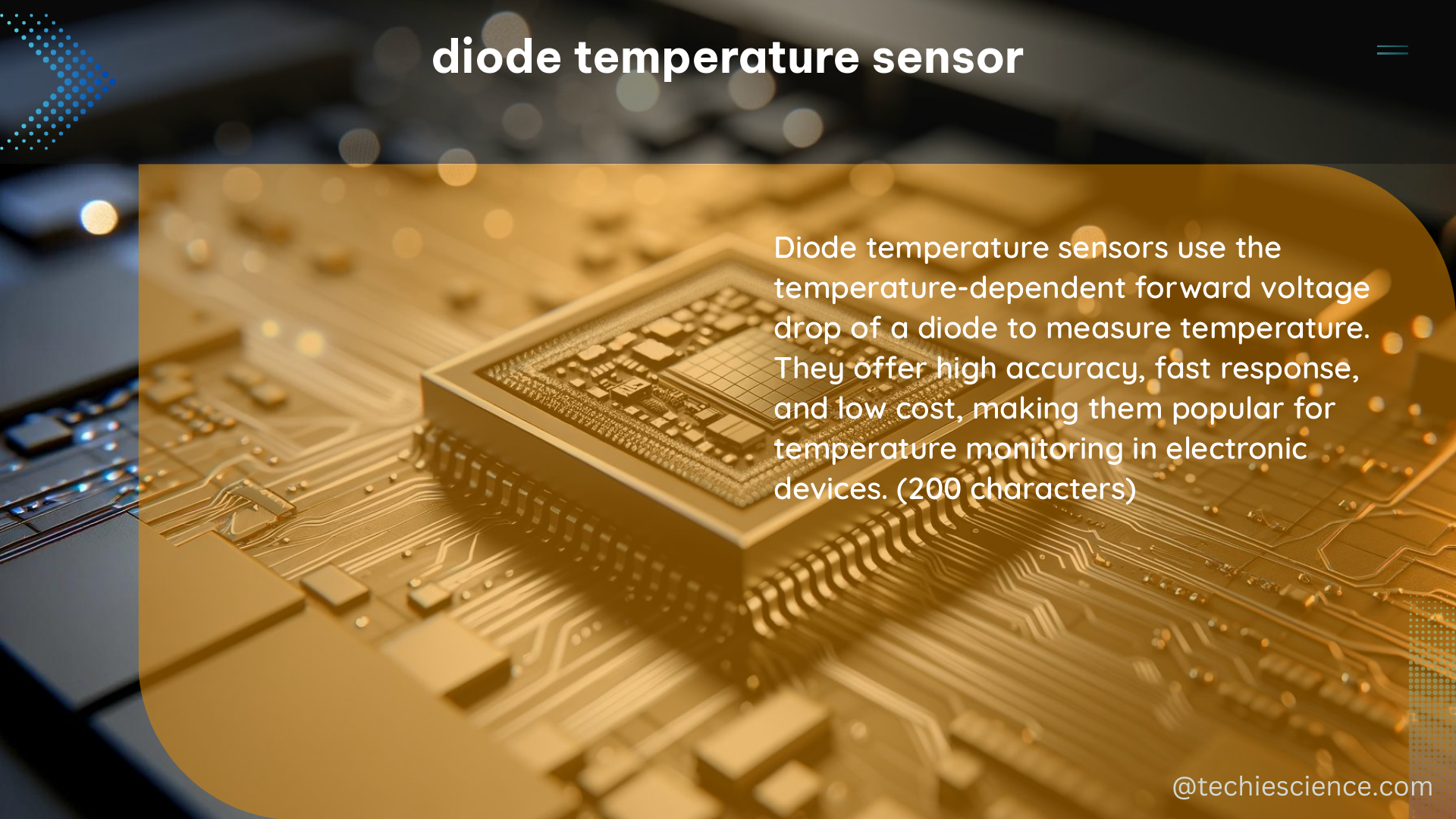Diode temperature sensors are widely used for temperature measurement in various applications due to their simple design, low cost, and moderate precision. The basic principle of diode temperature sensing is based on the temperature dependence of the forward voltage drop across a diode, which decreases with an increase in temperature, following Shockley’s diode equation.
Understanding the Fundamentals of Diode Temperature Sensors
Temperature Coefficient and Sensitivity
The sensitivity of diode-based temperature sensors can be quantified by the temperature coefficient, which is the rate of change of the voltage drop with respect to temperature. For silicon diodes, the temperature coefficient is typically around -2mV/°C, but this value can vary depending on the specific diode type and operating conditions. Some high-precision diodes can have a temperature coefficient as high as -4mV/°C, providing increased sensitivity for temperature measurement.
Differential Measurement Configurations
In practical applications, diode temperature sensors are often used in differential measurement configurations to improve accuracy and reduce the effects of external factors such as ambient temperature and self-heating. Differential temperature measurement involves comparing the voltage drop across a diode placed close to the heated component with the voltage drop across a reference diode. This approach can significantly improve the accuracy of temperature measurements, especially in high-precision applications, by canceling out common-mode errors.
Diode Selection and Characteristics
When designing a diode temperature sensor, the choice of diode is critical, as different diodes have different temperature coefficients and levels of noise. Some commonly used diode types for temperature sensing include:
- Silicon Diodes: Widely used due to their low cost and moderate temperature coefficient of around -2mV/°C.
- Germanium Diodes: Offer a higher temperature coefficient of around -4mV/°C but are more expensive and have higher noise levels.
- Schottky Diodes: Provide a faster response time and lower noise compared to traditional silicon diodes, making them suitable for high-speed temperature sensing applications.
- Zener Diodes: Can be used as temperature sensors, with a temperature coefficient of around -2mV/°C, and are often used in voltage reference circuits.
The choice of diode should be made based on the specific requirements of the application, such as temperature range, accuracy, response time, and cost.
Excitation Current and Self-Heating
The excitation current applied to the diode temperature sensor is another critical factor to consider. The excitation current should be chosen carefully to balance the need for sensitivity with the risk of self-heating. Excessive current can cause the diode to self-heat, leading to inaccurate temperature measurements. Typical excitation currents for diode temperature sensors range from a few microamperes to a few milliamperes, depending on the specific diode and application requirements.
Measurement Circuit Design
The measurement circuit design for a diode temperature sensor is also crucial for achieving accurate and reliable temperature measurements. The circuit should be designed to minimize noise and maximize accuracy. This may involve the use of differential amplifiers, filtering, and temperature compensation techniques. Additionally, the layout of the circuit board and the placement of the diode and associated components can have a significant impact on the overall performance of the temperature sensor.
Technical Specifications of Diode Temperature Sensors

Diode temperature sensors typically have the following technical specifications:
| Specification | Range |
|---|---|
| Temperature Range | -55°C to +150°C or higher, depending on the diode type and operating conditions |
| Temperature Coefficient | -2mV/°C to -4mV/°C, depending on the diode type and operating conditions |
| Accuracy | ±1°C to ±5°C, depending on the diode type, measurement circuit, and operating conditions |
| Response Time | Typically in the range of milliseconds to seconds, depending on the diode type and operating conditions |
| Power Consumption | Typically in the range of milliwatts to watts, depending on the diode type and operating conditions |
It’s important to note that these values are general guidelines, and the actual performance of a diode temperature sensor can vary significantly depending on the specific diode, circuit design, and operating conditions.
Practical Applications of Diode Temperature Sensors
Diode temperature sensors find widespread use in a variety of applications, including:
- Electronics and Semiconductor Devices: Monitoring the temperature of electronic components, such as microprocessors, power supplies, and power electronics, to prevent overheating and ensure reliable operation.
- Industrial Automation and Control: Measuring the temperature of machinery, motors, and other industrial equipment for monitoring, control, and optimization purposes.
- Automotive Systems: Monitoring the temperature of engine components, batteries, and other automotive systems to optimize performance and ensure safety.
- Medical and Healthcare: Measuring the temperature of patients, medical devices, and laboratory equipment for diagnostic and monitoring purposes.
- Household Appliances: Controlling the temperature of refrigerators, ovens, and other household appliances to ensure proper operation and energy efficiency.
- Aerospace and Defense: Monitoring the temperature of critical components in aircraft, satellites, and military equipment to ensure reliable performance and safety.
Conclusion
Diode temperature sensors are a versatile and cost-effective solution for temperature measurement in a wide range of applications. By understanding the fundamental principles, design considerations, and technical specifications of diode temperature sensors, engineers and technicians can effectively incorporate these sensors into their projects and achieve accurate and reliable temperature monitoring.
References
- Component Temperature Monitoring Using Differential Temperature Measurements, Texas Instruments, November 2021.
- Temperature vs diode voltage in Shockley’s equation, Electronics Stack Exchange, September 2021.
- Diode-Based Temperature Measurement, Texas Instruments, March 2018.
- The ‘thermal diode’…A diode or a transistor?, EE Times, September 2005.
- Appendix E: Temperature Measurement System, Lake Shore Cryotronics, Inc., 2014.

The lambdageeks.com Core SME Team is a group of experienced subject matter experts from diverse scientific and technical fields including Physics, Chemistry, Technology,Electronics & Electrical Engineering, Automotive, Mechanical Engineering. Our team collaborates to create high-quality, well-researched articles on a wide range of science and technology topics for the lambdageeks.com website.
All Our Senior SME are having more than 7 Years of experience in the respective fields . They are either Working Industry Professionals or assocaited With different Universities. Refer Our Authors Page to get to know About our Core SMEs.